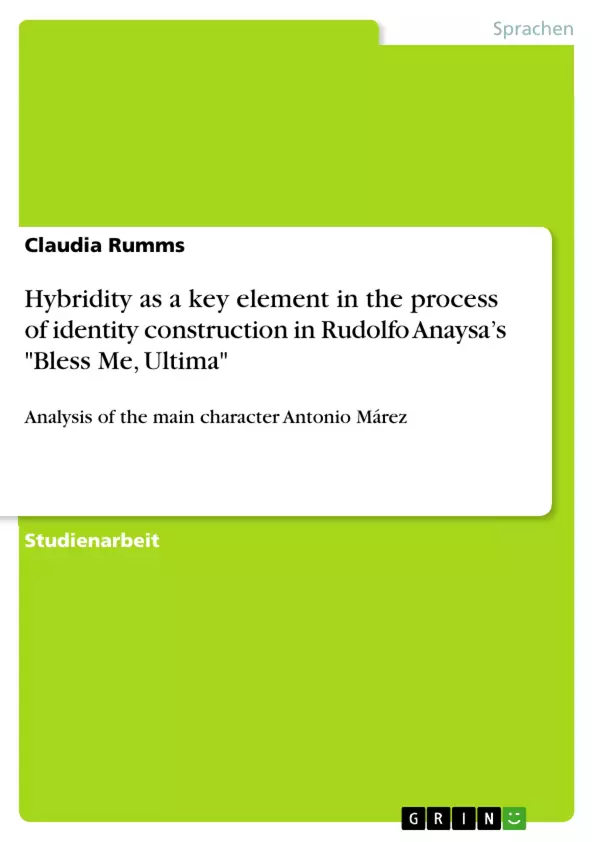The main focus of this term paper are the different steps and binary forces Antonio goes through and has to face in order to finally being able to constitute his transcultural identity. Furthermore, the paper should highlight the necessity of difference and a “double vision” which make the constitution of a new identity possible. Therefore my thesis is: Hybridity as a key element in Rudolfo Anaysa’s "Bless Me,Ultima" in the process of identity construction, exemplified in the main character Antonio Márez.
The term paper starts with the magical realist elements and features of the Bildungsroman present in "Bless Me, Ultima", which are part of the novel’s formal hybridity which is discussed in the subsequent paragraph, apart from the content-related hybridity. Afterwards, I will focus on Antonio’s search for identity throughout the novel with its different steps, from alienation at the beginning, his loss of innocence in the middle up to his final understanding and therefore the last step of his move from childhood to adolescence. Apart from the novel "Bless Me, Ultima" itself, the central literature I will work with is Angelika Köhler’s essay The New World Man: Magical Realism in Rudolfo Anaya’s "Bless Me, Ultima" and Juan Bruce-Novoa’s "Learning to Read" (and/in) Rudolfo Anaya’s "Bless Me, Ultima" .
“She took my hand, and the silent, magic powers she possessed made beauty from the raw, sun-baked llano, the green river valley, and the blue bowl which was the white sun’s home.” It is this opening paragraph in "Bless Me, Ultima" which introduces the reader directly to Antonio’s state of alienation at the beginning of the novel since these natural surroundings represent separated entities for him. And this is exactly what he is struggling with through the entire novel: There are several dichotomies in his life that seem irreconcilable to Antonio, especially the oppositional traditions of his parental lines, the Lunas and the Márez, and closely related to that the religious question he struggles with. When Ultima comes to live with his family, Antonio starts his journey towards self-discovery, going through different steps until he can finally complete his rites of passage and esteem his hybrid mestizo identity.
Inhaltsverzeichnis
- Introduction.
- Magical Realism and features of the Bildungsroman in Rudolfo Anaya's Bless Me, Ultima
- Formal and content-related hybridity in Bless Me, Ultima
- Antonio's search for identity in Bless Me, Ultima.
- Antonio's feeling of disintegration: Torn between the Márez and the Lunas
- Antonio's passage to maturity and a new sense of place in different steps
- Conclusion
Zielsetzung und Themenschwerpunkte
Diese Seminararbeit analysiert die Rolle der Hybridität in Rudolfo Anayas Roman "Bless Me, Ultima" im Hinblick auf den Prozess der Identitätsbildung des Protagonisten Antonio Márez. Die Arbeit untersucht, wie Antonio durch verschiedene Phasen seiner Entwicklung mit den widersprüchlichen Traditionen seiner Familienlinie (Márez und Luna) sowie mit religiösen Fragen ringt.
- Hybridität als zentrales Element der Identitätskonstruktion
- Die Darstellung des Bildungsromans in Verbindung mit Elementen des magischen Realismus
- Die Herausforderungen und Konflikte, denen Antonio in Bezug auf Kultur und Religion begegnet
- Die Bedeutung des "doppelten Sehens" für die Entwicklung einer hybriden Identität
- Antonia's Suche nach einem neuen Sinn für Zugehörigkeit und sein Weg zur Reife
Zusammenfassung der Kapitel
Die Arbeit beginnt mit einer Untersuchung der magisch-realistischen Elemente und Merkmale des Bildungsromans in "Bless Me, Ultima". Sie analysiert, wie diese Elemente zur formalen Hybridität des Romans beitragen. Im Anschluss wird die Suche nach Identität durch Antonio im Kontext seiner Kindheitserfahrungen und der Begegnung mit unterschiedlichen Traditionen beleuchtet. Es wird untersucht, wie Antonio mit der Spaltung zwischen den Familienlinien Márez und Luna, der indigenen und westlichen Kultur, sowie dem Spannungsfeld zwischen Englisch und Spanisch umgeht. Die Arbeit beleuchtet, wie Antonias Auseinandersetzung mit diesen Dichotomien seinen Weg von der Kindheit in die Adoleszenz prägt.
Schlüsselwörter
Die Arbeit konzentriert sich auf die Themen Identitätsbildung, Hybridität, magischer Realismus, Bildungsroman, kulturelle und religiöse Konflikte, Mestizaje, "doppeltes Sehen" und die Werke "Bless Me, Ultima" von Rudolfo Anaya und "The New World Man" von Angelika Köhler.
- Citar trabajo
- Claudia Rumms (Autor), 2015, Hybridity as a key element in the process of identity construction in Rudolfo Anaysa’s "Bless Me, Ultima", Múnich, GRIN Verlag, https://www.grin.com/document/428993



